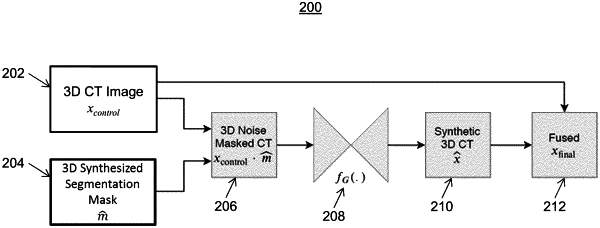| CPC G06T 7/0012 (2013.01) [G06T 7/11 (2017.01); G06T 17/205 (2013.01); G06T 2207/10081 (2013.01); G06T 2207/20081 (2013.01); G06T 2207/20084 (2013.01); G06T 2207/30061 (2013.01)] | 13 Claims |

|
1. A computer implemented method comprising:
receiving an input medical image;
generating a synthesized segmentation mask by:
sampling locations from a spatial probability map of abnormality patterns of a disease,
mapping the sampled locations from the spatial probability map to an image space of the synthesized segmentation mask,
generating individual masks each corresponding to a connected component region and positioned at a respective location of the mapped sampled locations in the image space of the synthesized segmentation mask, and
combining the individual masks to generate the synthesized segmentation mask;
masking the input medical image based on the synthesized segmentation mask, the masked input medical image having an unmasked portion and a masked portion;
generating an initial synthesized medical image using a trained machine learning based generator network, the initial synthesized medical image comprising a synthesized version of the unmasked portion of the masked input medical image and synthesized abnormality patterns of the disease in the masked portion of the masked input medical image;
blending the initial synthesized medical image with the input medical image to generate a blended image; and
fusing the synthesized abnormality patterns extracted from the blended image with the input medical image to generate a final synthesized medical image.
|